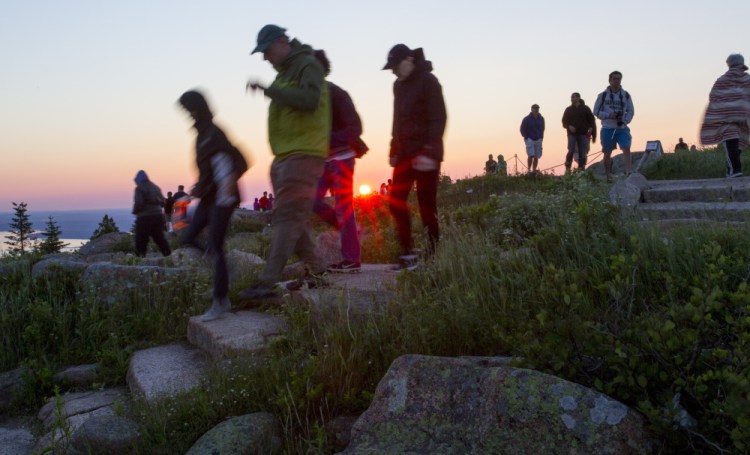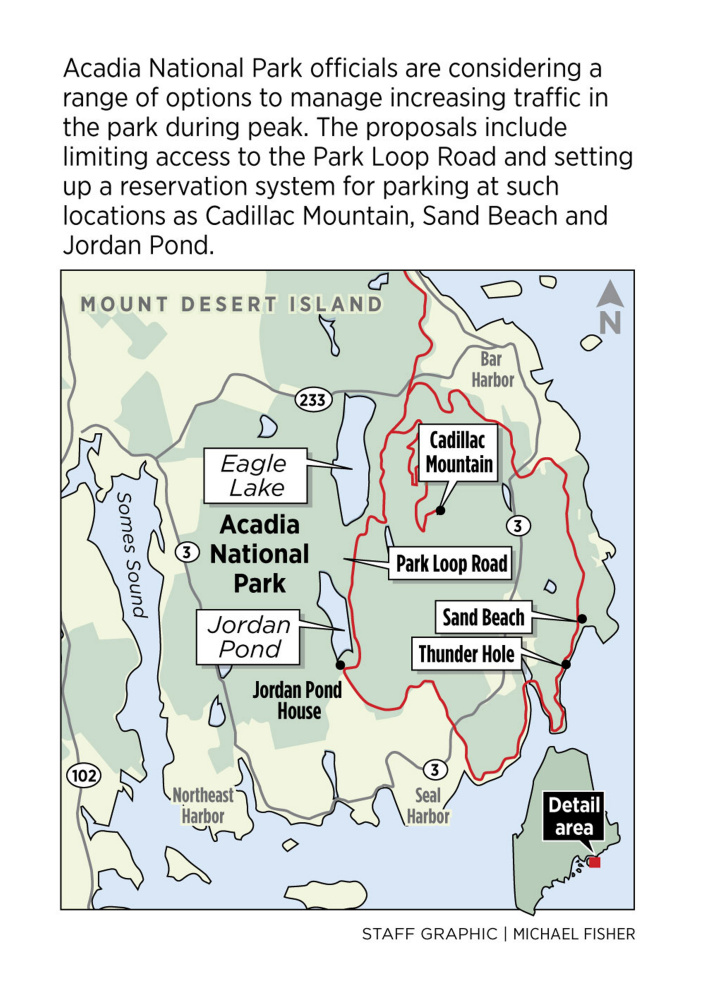Reservations could be required to drive up Cadillac Mountain or park at Acadia National Park’s Sand Beach. Access to Park Loop Road could be “metered” at peak times to avoid a scenic drive clogged with cars. And cyclists could be given more – or less – space and time to cruise Acadia’s winding roads.
Those are a few of the options floated as “conversation starters” by Acadia National Park officials as they seek ways to address the growing challenges of traffic jams, crowds and parking shortages at one of the nation’s most popular national parks. The process is still in the early stages and is expected to last until at least the fall of 2018. But the National Park Service is seeking public comment through Nov. 30 on several preliminary proposals that would, if adopted, significantly change the way users visit some of the most popular spots within the 47,000-acre park.
The preliminary proposals outlined in a park service newsletter include:
– Requiring private vehicles to obtain reservations to visit Cadillac Mountain, Sand Beach or Jordan Pond House during peak times.
– Restricting the number of vehicles on the busiest stretch of Park Loop Road during the busiest times.
– Changing the directional flow of vehicle traffic on Park Loop Road as well as rules on cyclists’ usage of the road.
– Eliminating right-lane parking along some stretches of Park Loop Road to improve traffic flow while expanding parking lots in other areas.
Park officials stressed that the proposals are only draft options that are by no means set in stone. Any major changes, such as a parking reservation system, would take time to implement after the plan’s adoption in 2018 and, even then, may only be activated when needed because of traffic conditions.
“What is out there now is not the (final) plan,” said John Kelly, spokesman for Acadia National Park. “They are just ideas on paper that people can react to.”
Those reactions have already started to come in from the local communities. Nearly 300 people attended two “open house” meetings in Bar Harbor and Prospect Harbor on the transportation plan last week. During the meetings, park representatives allowed attendees to post comments or suggestions that will be taken into consideration as they develop the draft transportation plan to be released next year.
David MacDonald, president and CEO of the nonprofit Friends of Acadia, said it “goes without saying” that many of the concepts outlined by Acadia officials will be controversial among local residents and other Mainers accustomed to easy access to key sites. Yet MacDonald praised the park service for beginning what he said is a much-needed conversation.
“The status quo is not working,” said MacDonald.
Crowds and vehicles at certain locations – such as atop Cadillac Mountain as well as at Sand Beach and Jordan Pond – are already affecting the visitor experience. While MacDonald said the problems are more severe in the park’s “front-country and not the backcountry,” one challenge will be to address those issues without creating new ones elsewhere.
“Those are areas that are screaming out for more creative solutions right now, but it doesn’t mean there aren’t other areas that are bubbling to the surface,” MacDonald said. “It is getting to the point where it is not functional at those spots.”
Acadia could be on a record-setting pace for visitation this year.
Just over 2.8 million visitors came to Acadia as of the end of September, which is almost dead-even with visitation figures for all of 2015. Kelly said total visitation for 2016 is on track to crest the 3 million figure for the first time since the National Park Service switched to a new method of counting visitors in the mid-1990s.
Part of this year’s spike is likely attributable to the fact that 2016 marks the centennial of both the National Park Service and Acadia National Park, which officially began life as Sieur de Monts National Monument in 1916. Yet Acadia’s visitation figures have been increasing for much of the past decade.

Cloud cover sweeps over the top of Bar Island as seen from the summit of Cadillac Mountain one day last June. On busy summer days, anywhere from 3,000 to 5,000 people may visit Cadillac, which offers sweeping vistas from atop the highest peak on the Eastern Seaboard.
The crowding and traffic problems are most glaring on Cadillac, with its 130 parking spots and winding mountain road. On busy summer days, anywhere from 3,000 to 5,000 people may visit Cadillac, which offers sweeping vistas of Frenchman Bay from atop the tallest peak on the Eastern Seaboard.
Kelly noted that the road up Cadillac Mountain was constructed in 1932 and, like parts of the Park Loop Road, was purposely built with curves, scenic turnouts and other characteristics designed to show off the views. So when there is traffic congestion or no parking up top, that detracts from the experience.
“It’s not about the numbers,” Kelly said. “It is about the quality of the people’s visit, their experience and, more importantly, their safety.”
The park service sketched out four “preliminary concept” scenarios for Acadia’s parcels on Mount Desert Island as well as two preliminary concepts for Schoodic Peninsula, which currently sees much less usage. There are also “no change,” status quo options for both areas.
The four options for MDI offer a variety of scenarios.
Some propose a “metering” system that aims to regulate the number of cars entering the popular Ocean Drive section of the Park Loop Road at the current entrance station. Several scenarios discuss reservation systems for visitors to Cadillac, Sand Beach and Jordan Pond.
A third scenario envisions a reservation-only system for cars on Park Loop Road – but only during peak usage times – with all vehicles funneled through two new entrance stations. The most sweeping proposal would require visitors to take tour buses or shuttle buses on Park Loop Road during the peak season, although private vehicles would be allowed during the non-peak and the shoulder seasons.
Several national parks already prohibit or significantly restrict personal vehicles on major thoroughfares. Visitors to Zion National Park in Utah, for instance, can only access Zion Canyon via free shuttle bus between April and October.
At Acadia, there is also discussion of replacing the commercial bus tours that drive up Cadillac or along Park Loop Road with a contractor – or concessionary – hired by the National Park Service, similar to programs offered in other parks. The park service has also floated the options of switching Park Loop Road to two-directional traffic throughout and changing cyclists’ access to Park Loop and Cadillac Summit roads.
Martha Searchfield, executive director of the Bar Harbor Chamber of Commerce, said local businesses and residents are still digesting the proposals. But she called Thursday night’s meeting in Bar Harbor – which drew about 200 participants – a “great experience” that allowed people to participate in a process that will affect both the park and Bar Harbor.
“The town and the park blend right into each other,” said Searchfield. “The park and the town sort of grew up together, so it is not an easy undertaking. … These are the steps we have to take. Bar Harbor itself has formed a task force to look at their parking and transportation issues.”
Kelly said some local residents or businesses have already broached the idea of special passes for local residents. Those and other suggestions will be considered by park representatives as they work toward the next stage in the planning process. He said there will be at least two additional “public reviews” before a plan is adopted.
MacDonald said Friends of Acadia is encouraging interested individuals to share their thoughts and suggestions with the park service.
“Public involvement at this early stage is still really, really important,” MacDonald said.
More information on the Acadia National Park transportation plan – including the newsletter detailing preliminary options – is available online at: parkplanning.nps.gov/acadtransportationplan
Send questions/comments to the editors.






Success. Please wait for the page to reload. If the page does not reload within 5 seconds, please refresh the page.
Enter your email and password to access comments.
Hi, to comment on stories you must . This profile is in addition to your subscription and website login.
Already have a commenting profile? .
Invalid username/password.
Please check your email to confirm and complete your registration.
Only subscribers are eligible to post comments. Please subscribe or login first for digital access. Here’s why.
Use the form below to reset your password. When you've submitted your account email, we will send an email with a reset code.